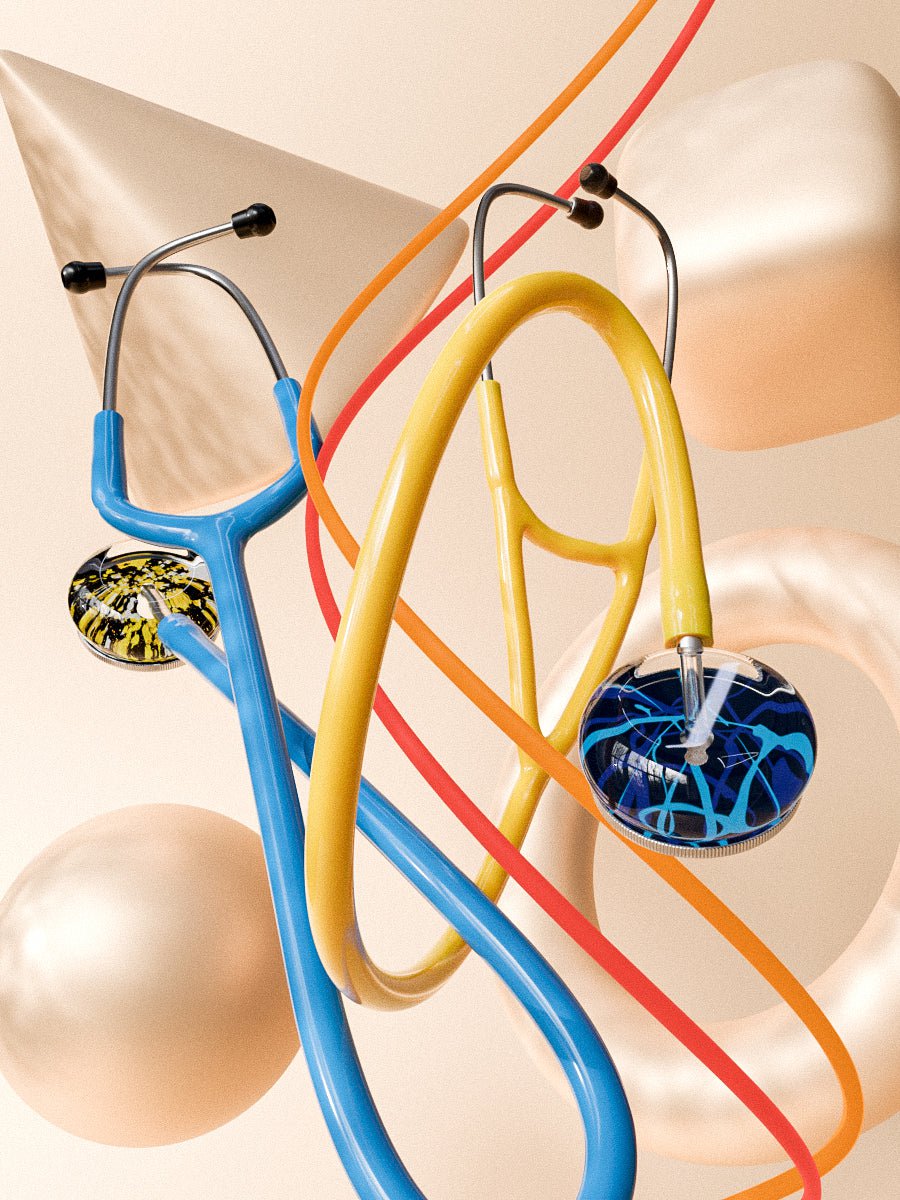A stethoscope is a vital tool for every doctor and nurse during their practice. Its main functions are being able to hear sounds from inside the body such as a heartbeat or belly gurgles. The doctor then interprets these sounds to make a diagnosis.
However, a stethoscope is susceptible to damage due to wear and tear and other factors that can lead to it needing to be replaced. Just like other products, manufacturers recommend a specified period to replace your product. Most stethoscope manufacturers recommend that you replace it every two years. When you need to replace your stethoscope, be sure to check out Ultrascope! We have many colors and patterns so you can exhibit your own personal style.
However, how true or valid is this timeframe of 24 months? From a business point of view, they want to continue making a profit when you have to purchase a new stethoscope every two years. This is seen by many medical professionals to be the case since some doctors have used the same stethoscope for years without replacing it and they are still effective. Others say once the recommended lifespan has passed, the instrument becomes worn-out, which can lead to it easily being damaged.
The thought of replacing a stethoscope when it breaks should not worry you. You should always look for signs that tell you it’s time to replace your stethoscope. It is simply not advisable to continue to use the same stethoscope for a long period without replacing it.
How often you replace your stethoscope will depend on a number of different factors rather than a definite set period.
Wear and tear
The average day of a stethoscope is tough. It collects oils from the skin, which will ultimately wear it out. You should be cleaning it in between patients, as well as if it has been receiving knocks from beds, chairs, counters, and other equipment in your work environment. The twisting and folding of the tubing can also lead to an increase in the possibility of it wearing out quicker than it should. All these factors will eventually lead to your stethoscope suffering damage, and gradually wearing out.
Minor knocks or damage to parts can be resolved by replacing the specific part, such as the earpiece. However, damage to the main part body of the instrument will require the need of a new stethoscope.
Upgrading to the latest version
Technology is always increasing and the innovation of better products is constantly progressing. If you haven’t been keeping up to date with the latest trends in the field of stethoscopes, you may not realize how outdated your stethoscope has become. You need to be on top of the market to know all about the new models with advanced tubing, single-piece diaphragm, and improved sound effect.
If you have no idea about the latest stethoscope technology, it might be time to spend a little bit of time researching the current trends, and if need be, consider updating your current stethoscope to something a little more modern.
Malfunctions
Stethoscopes are manmade products, and mistakes can occur unknowingly. When your colleagues are hearing things through auscultation that you did not hear, or diagnostic tests showing things that you missed, it is high time to replace your stethoscope. Making errors in your checkups or missing some vital signs when examining a patient may put them in danger.
You cannot risk having an incorrect diagnosis because of your faulty or worn-out stethoscope. As soon as your become aware of signs that you’ve missed during any examinations, you need to replace the stethoscope.
Increase accessibility
The reason for replacing a stethoscope may not be that you actually need a new one, but are simply adding to the existing one. You may need several stethoscopes at your workplace, home, and carrying one for emergencies. The extra stethoscope will be a backup when the other may have broken down or if you left it at a previous location. If you only have one stethoscope and are carrying it at all times, it will deteriorate quickly. Having several for accessibility in different locations is good practice, and can lead to them each having a longer lifespan.
Loss
It is a frustrating reason for replacing a stethoscope. Unfortunately, we live in a society where theft and loss do occur. If you have had your stethoscope stolen, or have misplaced it somewhere, you must replace it immediately.
How to prolong your stethoscope life
Earpieces are the most used part of a stethoscope and wear out quickly. They can also carry hospital-borne infections. Changing your stethoscope earpieces will improve the quality of sound. You do not need to buy a new stethoscope. You can simply replace the earpieces and the stethoscope can be used for a longer time. Though most providers give an extra set of earpieces, you can always purchase replacements if required.
Most stethoscopes are made of PVC, which means that the tubing starts to become hander when continuously exposed to human skin that contains oils. This is the first sign that your stethoscope is wearing out. This is however preventable. Wear your stethoscope over the lab coat collar to avoid any contact with the neck.
The normal usage of the stethoscope will lead to the diaphragm deteriorating over time. The chest piece should be airtight at all times. Otherwise, air will escape from the diaphragm, which will start affecting the quality of sound. A regular check of the chest piece will ensure the seal is intact for better and longer use of the stethoscope.
Cleaning your stethoscope regularly with the recommended cleaning agent will increase its lifespan. Using strong and harsh chemicals will bleach the parts and wear them out quickly. Never submerge the stethoscope in your cleaning agent to prolong its life – it will do the opposite.
Always store your stethoscope in a cool and dry place when not in use. You should have a carrying case for our stethoscope to avoid damage and contamination while mixed with other items.
How best to look after your stethoscope
Below we will take a look at some of the best ways in which you can take care of your stethoscope.
- Clean the stethoscope in between examining patients. The use of disposable wipes is best to remove organic material.
- Do not immerse the stethoscope in a cleaning agent or any liquid. This is because they are not waterproof and can become damaged by soaking.
- Never put your stethoscope through any sterilization process. Most sterilization processes are abrasive and harsh and will break or damage the stethoscope.
- The stethoscope should be kept away from extreme cold and high temperatures, oils, and solvents. The PVC material used to make the stethoscope can be damaged by very low or high temperatures. This may change the pressure in the tube hence interfering with hearing.
- Regularly remove debris from the earpiece to avoid the accumulation of dirt that will affect the sound quality.
- Never use hand sanitizer to clean the stethoscope, as it contains additives that may spoil parts of the stethoscope.
- Do not change your ear pressure to improve the positioning of the earpiece. Pressure change remains in the tube. Changing your ear pressure will affect the sound travel making it difficult to hear.
- Earpieces can be removed for proper cleaning but be careful while removing them from the headset. Ensure the surface is clean and dry to prevent the earpiece from collecting other debris and moisture. Reassemble carefully to avoid damages. If a part is lost or broken, replace it.
- The tube is made from PVC that wears out quickly when exposed to oils from the skin. Wearing it over the collar of the coat will maintain its functionality for a longer period of time.
- Avoid knocks to the stethoscope from tables or chairs to prevent damage or cracks that may lead to more serious damage.
- Sometimes you may be eager to leave work when your shift ends, leading you to fold the stethoscope and store it anywhere. Proper storage such as a bag or carefully hanging it in its place or locker is better. This will reduce the potential for damage.
- Since the stethoscope comes from different manufacturers, it is important to know the best practices for your specific model. Knowing how to clean, position, reassemble and put the parts back is important in maintaining the stethoscope.





